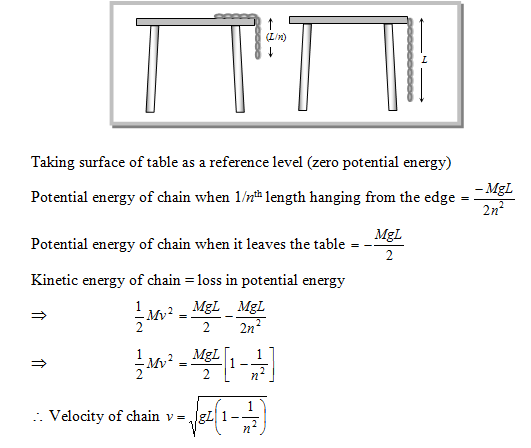
The physics formula for the velocity of chain while leaving a table is a classic problem in physics, demonstrating principles of conservation of energy and kinematics. This problem is often used to illustrate how objects fall under the influence of gravity.
Velocity is a vector quantity in physics that describes the rate of change of an object's position with respect to time. It has both magnitude (speed) and direction, which means it tells you not only how fast an object is moving but also in which direction it is moving. Velocity is often represented by the symbol "v" and is measured in units like meters per second (m/s) in the metric system or feet per second (ft/s) in the imperial system. Mathematically, velocity can be defined as: Velocity =Change in Position \Change in Time Where: -Change in Position represents the change in position (how far the object has moved). - Change in Time represents the change in time (the time interval over which the object moved). Velocity can be positive, negative, or zero, depending on the direction of motion. Positive velocity indicates motion in one direction, negative velocity indicates motion in the opposite direction, and zero velocity indicates no motion. The velocity of a chain, when it leaves a table and falls under the influence of gravity, depends on the height from which it falls and the local acceleration due to gravity. As mentioned earlierAlso Check - Work, Energy & Power Formula
Here's the scenario: Imagine you have a chain hanging vertically off the edge of a table. At some point, you release the lower end of the chain, and it falls to the ground. You want to calculate the velocity with which the chain leaves the table.
Imagine you have a chain hanging vertically off the edge of a table. At some point, you release the lower end of the chain, and it falls to the ground. You want to calculate the velocity with which the chain leaves the table.
Also Check - Heat Transfer Formula
The key concepts and equations involved in solving this problem are:- Conservation of Energy:
- Gravitational Potential Energy (PE):
Also Check - Thermodynamics formula
- Kinetic Energy (KE):
Example Of Velocity of Chain While Leaving the Table Formula

Some Examples
- Why does the chain accelerate as it falls off the table?
- Does the mass of the chain affect its velocity as it leaves the table?
- What happens if the chain is dropped from a greater height?
- Does air resistance affect the velocity of the chain as it falls?
- What happens if the chain is initially given some horizontal velocity as it leaves the table?
Velocity of Chain While Leaving The Table Formula FAQs
Why does the chain accelerate as it falls off the table?
The chain accelerates as it falls off the table due to the force of gravity. Gravity exerts a constant acceleration on all objects near the Earth's surface, causing them to gain speed as they fall. This acceleration is approximately 9.81 meters per second squared (m/s²) on Earth.
Does the mass of the chain affect its velocity as it leaves the table?
Yes, the mass of the chain does affect its velocity as it leaves the table. Heavier objects require more force to accelerate, so a heavier chain will accelerate more slowly than a lighter chain when released from the same height. However, when calculating the velocity using the formula, you'll notice that the mass cancels out, meaning that all objects, regardless of mass, will fall with the same acceleration due to gravity and reach the same velocity when falling from the same height.
What happens if the chain is dropped from a greater height?
If the chain is dropped from a greater height, it will have a higher velocity when it leaves the table. This is because the gravitational potential energy (PE) is directly proportional to the height (h), so a greater initial height results in more potential energy. When the chain falls, this energy is converted into kinetic energy (KE), leading to a higher velocity.
Does air resistance affect the velocity of the chain as it falls?
In most introductory physics problems, air resistance is neglected to simplify calculations. However, in reality, air resistance does affect the velocity of falling objects. If air resistance is significant, it can slow down the chain's descent, and its actual velocity as it leaves the table would be slightly lower than what is calculated using the simplified formula.
🔥 Trending Blogs
Talk to a counsellorHave doubts? Our support team will be happy to assist you!

Check out these Related Articles
Free Learning Resources
PW Books
Notes (Class 10-12)
PW Study Materials
Notes (Class 6-9)
Ncert Solutions
Govt Exams
Class 6th to 12th Online Courses
Govt Job Exams Courses
UPSC Coaching
Defence Exam Coaching
Gate Exam Coaching
Other Exams
Know about Physics Wallah
Physics Wallah is an Indian edtech platform that provides accessible & comprehensive learning experiences to students from Class 6th to postgraduate level. We also provide extensive NCERT solutions, sample paper, NEET, JEE Mains, BITSAT previous year papers & more such resources to students. Physics Wallah also caters to over 3.5 million registered students and over 78 lakh+ Youtube subscribers with 4.8 rating on its app.
We Stand Out because
We provide students with intensive courses with India’s qualified & experienced faculties & mentors. PW strives to make the learning experience comprehensive and accessible for students of all sections of society. We believe in empowering every single student who couldn't dream of a good career in engineering and medical field earlier.
Our Key Focus Areas
Physics Wallah's main focus is to make the learning experience as economical as possible for all students. With our affordable courses like Lakshya, Udaan and Arjuna and many others, we have been able to provide a platform for lakhs of aspirants. From providing Chemistry, Maths, Physics formula to giving e-books of eminent authors like RD Sharma, RS Aggarwal and Lakhmir Singh, PW focuses on every single student's need for preparation.
What Makes Us Different
Physics Wallah strives to develop a comprehensive pedagogical structure for students, where they get a state-of-the-art learning experience with study material and resources. Apart from catering students preparing for JEE Mains and NEET, PW also provides study material for each state board like Uttar Pradesh, Bihar, and others
Copyright © 2025 Physicswallah Limited All rights reserved.
Get App









